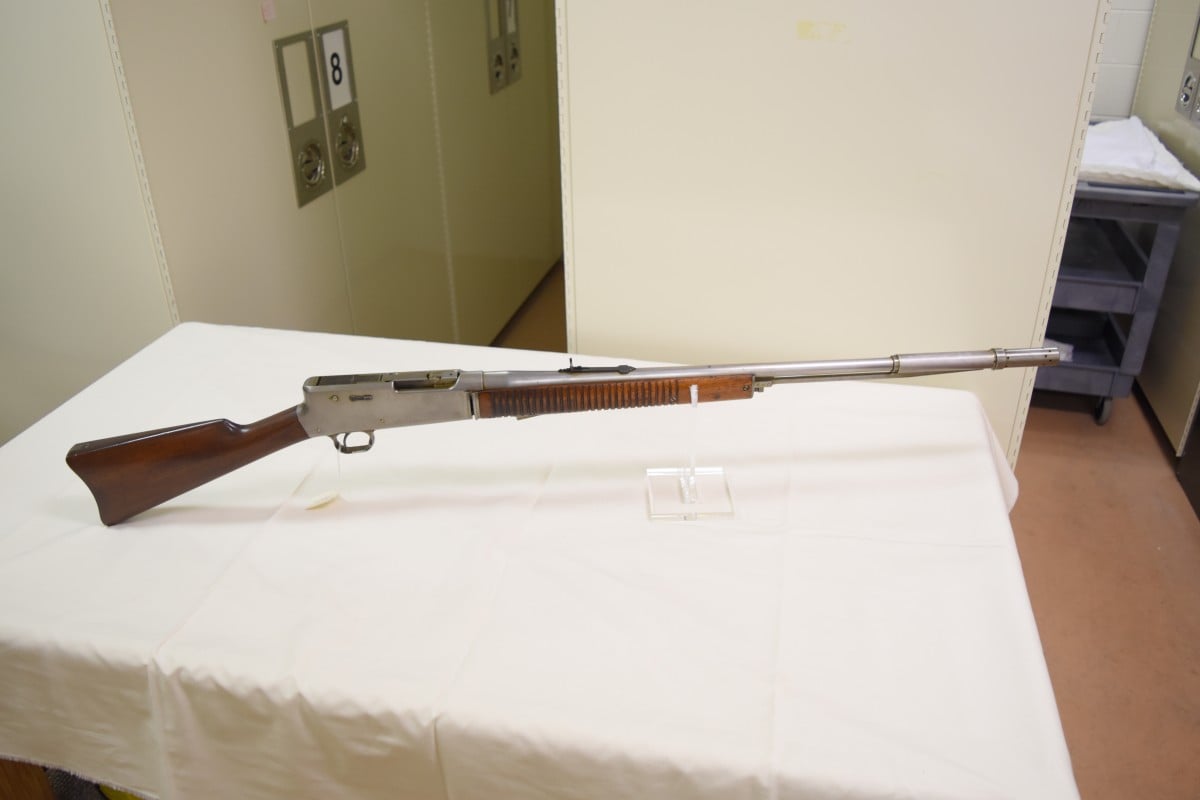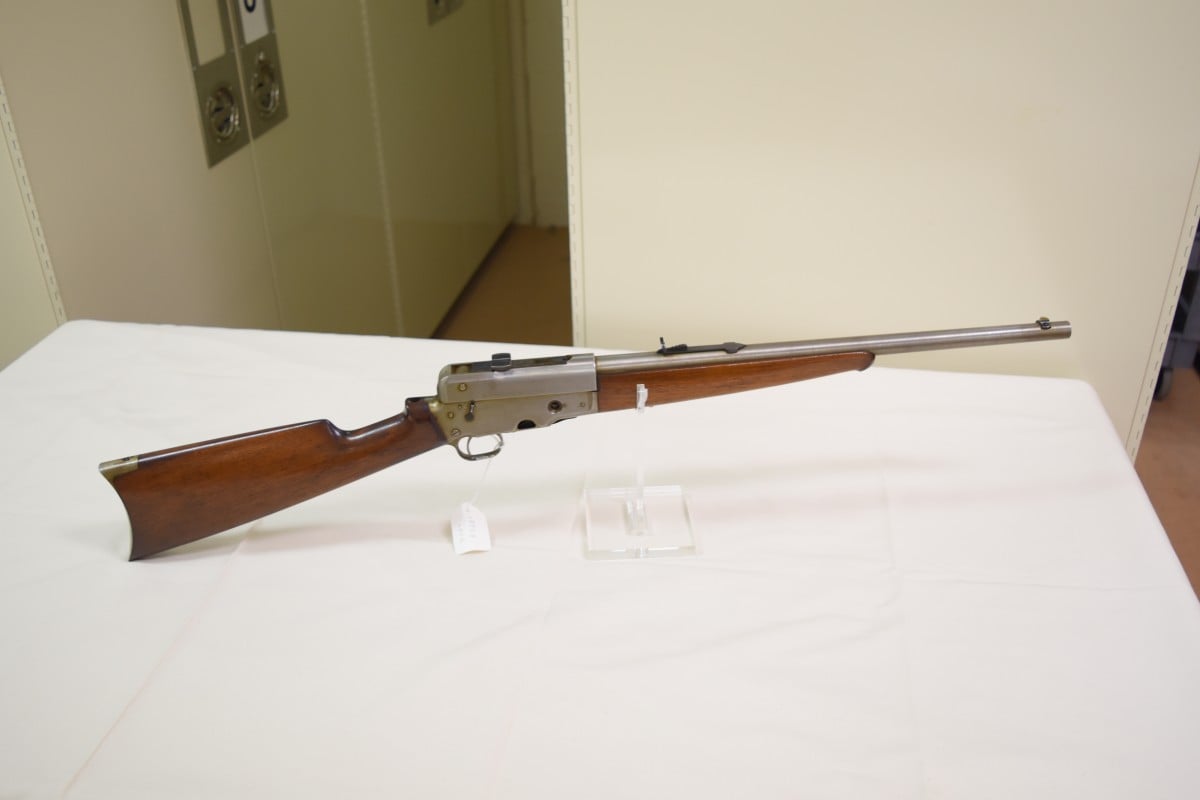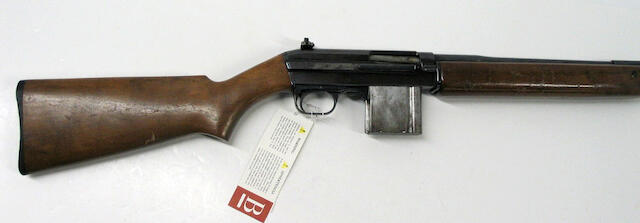William Mason’s Experimental Toggle Link Firearms
June 14, 2017 by Kyle Hestand
Share
The late 19th and early 20th century saw a broad push by arms manufacturers to build self-loading firearms. In this blog post I will be highlighting several of the Winchester Repeating Arms Company’s early prototypes designed by William Mason and T. G. Bennett. Competition between firearms manufacturers was fierce and Winchester wanted a technological edge over their competition. They turned to William Mason, the man who helped created the legendary Colt Single Action Army. Mason experimented with several types of gas and recoil operated designs. Mason had a series of interesting prototypes that were based on Hugo Borchardt’s toggle link design and development persisted on a rifle, carbine and shotgun, despite Borchardt threatening lawsuits for patent infringement.

Mason’s toggle link rifle with the action fully closed.


Stendebach 1936

C.G. Haenel Roth-Krnka 1899 Semi-Automatic


Rheinmetall side toggle-action semi-automatic prototype rifle in 7.92x57mm, designed by German Karl Heinemann.
This exact gun is photographed on pages 150-151 of Hatcher’s Notebook, written by Major General Julian S. Hatcher who was Chief of Small Arms Division, Ordnance among various other titles.
The caption below a photo in his book states, “Heinemann semiautomatic rifle, made for the 7.92mm German service cartridge, captured in Germany during World War II. This is very similar to the .276 model of this gun that was tested in Aberdeen Proving Ground in 1929.”
Karl Heinemann’s U.S. patent, Automatic Firearm, number 1,275,272 was received August 20th, 1929.
5 Likes

Savage-Stevens Model 85M Prototype M1 Garand Trainer Trials Rifle -detachable 10 round box magazine-
serial #X87-7, 22 LR, 24" barrel with a bright excellent bore. The metal surfaces on this very interesting trainer retain about 98% original factory blue. The walnut stock has been custom made by Savage to closely resemble and feel like the full-size M1 Garand rifle stock. The walnut stock and handguard rate very good plus to excellent with only sparsely scattered very light dings or handling marks here and there, it is fitted with a heavy steel checkered buttplate. The arm is a basic Stevens Model 87 barreled action (the barrel is actually marked “Model 57” beneath the wood handguard) set into the custom stock but with a detachable 10 round box magazine, and has had a custom banded front sight made, to closely resemble the M1 Garand front sight, the military-style rear aperture sight is no longer present, its drilled and tapped hole is atop the receiver (these were stamped sheet metal affairs and could be easily fabricated by the right gunsmith). Unlike the later-production versions of these guns, which were tube fed and had the magazine tube protrude from of the stock, the front sight band on this example featured a lower lobe which supports a blued steel tube, appearing externally very much like the lower gas tube on the Garand rifle. The civilian versions as well had had milled “cooling” cuts in the stock left and right just ahead of the junction of the barrel and action, they have been very neatly filled on this example, both the stock and handguard being numbered “773” on their interior. Purportedly in 1956, the Marines sent letters out to a number of firearms companies inviting them to submit test rifles which the Corps was considering utilizing as a training aid, prior to live fire with actual M1 Garand rifles. The 10 basic characteristics the Corps needed in the rifle were: rifle must be semiautomatic; must have a 10 round detachable box magazine; rifle must be stocked to simulate to the U.S. Rifle M1 caliber 30; stock must be equipped to take military style 1 1/4" inch sling; sights must present the same sight picture as the M1 rifle and be adjustable for both windage and elevation; windage and elevation adjustments must be similar to that of the M1 rifle; rifle must have a positive, easily operated manual safety; rifle must operate with a minimum of malfunctions under numerous conditions and be capable of firing 1000 rounds with a minimum of malfunctions; rifle must be able to use standard velocity ammunition; manufacturer must be able to ensure spare parts for replacement. While there is no proof that this arm had anything to do with the Marines invitation to submit rifles, it certainly would of course explain the 10 round detachable box magazine on this gun, these normally having of course tubular magazines as-mentioned. History appears to have confirmed that the Marines never awarded any contracts for any trainers and the arms were to be returned to the respective factories, it is likely this gun sat in the Savage Reference Collection all that time. The sling swivels are missing from the arm but they would be easily replaced if one wished. The included factory letter confirms the arm’s configuration and identifies it as a “Model 85M Military Prototype” from the Savage Factory Reference Collection. The letter dated in 1988 shows sale to a prominent Massachusetts gun dealer and further states “Sold from the Savage Arms Product Engineering Department Archives: Reference Collection”. A really super training rifle that was clearly designed, and perhaps even submitted, to curry military favor as an M1-Garand trainer. (38716-1) {C&R}

Standard Swebilius patent prototype .35 Remington caliber semi-automatic sporting rifle


serial #X21, 9 mm, 12’’ barrel with a bright excellent bore. The secondary offering of the pair, this extremely rare experimental prototype carbine was a Second World War attempt by Smith & Wesson to garner police and military contracts for a lightweight handy carbine of pistol caliber that was superior to the light rifle; the project was however halted in the middle due to the dire need for wartime production. The metal surfaces retain about 95-97% original gray parkerized finish, the loss being only some sharp edge and contact point wear along with normal scattered minor handling marks. The smooth pistolgrip walnut buttstock and handguard rate very fine to excellent with the expected sparsely scattered light dings and handling marks that come from the years, a very tiny flake missing from ahead of the bottom metal. The front band has a sling swivel attached on its left side while the buttstock is milled for sling attachment, very much like the M1 carbine. There is a tiny plugged hole along the toeline which no doubt held a swivel stud prior to Smith & Wesson’s design change involving the stock milling. Indeed the included promotional pamphlet from Smith & Wesson: ‘‘Smith & Wesson Carbine’’, lists all the carbine specifications and details, and shows the fixed-stock version without sling cut on its cover. The arms featured detachable box magazines of both 15 and 30 round capacity (none is included), and the included factory letter from Roy Jinks indicates that they take STEN gun magazines. There is a simple flat blade or post style front sight affixed to a barrel band base and a simple elevation adjustable rear peep sight showing two elevation clicks. The left-side of the receiver is neatly stamped with hand stamps with the Smith & Wesson address and showing a patent date of January 13, 1945. The arm fires from a locked breech and the safety lock is located within the triggerguard at its very front. What is likely the original factory leather sling is included. Included is an exemption letter from the BATFE, removing the arm by serial number from the provisions of the NFA as a curio and relic. A copy of the very rare promotional pamphlet is included as well as a factory letter from Roy Jinks indicating that only five of these very rare carbines were ever produced, this example being finished in June of 1945. A second extremely rare Smith & Wesson carbine for the advanced Smith & Wesson collector, also directly from the collection of Mr. Roy Jinks. (38840-118) {C&R} [Roy Jinks Collection]


2 Likes







